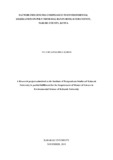FACTORS INFLUENCING COMPLIANCE TO ENVIRONMENTAL LEGISLATION ON POLYTHENE BAG BAN IN RONGAI SUB-COUNTY, NAKURU COUNTY, KENYA
Abstract
Polythene bags have been preferred for packaging purposes because they are light in weight, cheap and resistant to degradation. Despite the benefits, poor disposal of polythene causes degradation of soil, water, land and air resources leading to health problems. Burning polythene releases Greenhouse gases mainly Carbon dioxide, associated with Climate change. Furthermore, polythene kills wild game, livestock and aquatic organisms. The adverse effects of polythene bags in the country led to introduction of legislation in the year 2017, banning light weight single-use polythene bags and in March 2019 on polypropylene bags as a mitigation measure. However, Reports of polythene bags presence in the Rongai Sub-County indicate lack of compliance of the legislation. Therefore, the aim of the study was to determine factors influencing compliance of environmental legislation on polythene bag ban in Rongai sub-county, Nakuru County, Kenya. The objectives aimed by this research study were to: determine the levels of awareness of the legislation; assess the perceived environmental effects of polythene bags; examine the influence of polythene bag alternatives on extent of compliance of the legislation and establish the extent to which enforcement capacity influence compliance of the legislation on polythene bag ban. This descriptive research design was employed from a target population of 147,017 (18,377 households) and 580 traders, proportionate stratified random sampling of 265 respondents in the five wards were sampled. Six Key informants were selected using purposive sampling; 5 chiefs from respective wards and one Environmental Compliance officer in the Sub-County, bringing a total of 265 in number. Instruments used for collecting data included; piloted questionnaires (0.74cronbach‘s alpha level) used on households and traders while interviews conducted for key informants. A focus group discussion of 5-10 members in each ward was held. Photography and Non-participant observation was adopted to add on collected information collected. Data analysis was done using computer software statistical packages for social sciences (SPSS version 22). Descriptive statistics was used to measure central tendencies with Chi-square at 5% level of significance ((=0.05) while Correlation and multiple regressions was used in inferential statistics. Familiarity on the ban of commonly used polypropylene bags was widely agreed at ( 2 =317, P<0.0001) while the least association was responses agreeing that there was sufficient awareness at ( 2 =52.4, P<0.0001). Hundred percent of the respondents significantly agreed at ( 2 =46.7, P<0.0001) that polythene bags kill livestock. 46.53 percent of the respondents agreed that cost for alternative materials carrier bags was expensive at ( 2 =156, P<0.0001). 48.16 percent agreed that Understaffing was affecting NEMA enforcement of the legislation at ( 2 =144.5, P<0.0001). In conclusion, the respondents had low awareness levels, lacked good quality alternatives and enforcement agency was found to be lacking the capacity to ensure adherence to the legislation. The study therefore recommends improved awareness campaigns of negative effects of polythene bags and incorporation of all stakeholders in the formulation of environmental policies and legislation in Kenya.

